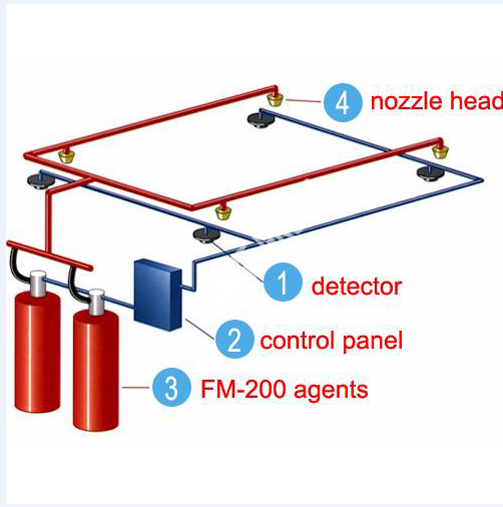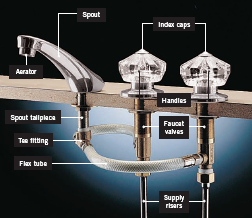CENTRAL AIR CONDITIONING
what is chiller plant ?
Major components :
- Building or process cooling load
- water cooled chiller ( this can be air cooled )
- Cooling Tower
- Pumps and piping
- controls
A - Air cooled chiller
IN(Air cooled chiller) the Condenser is cooled using air
B- Water cooled chiller
- IN this type the condenser is cooled using water . water is then cooled using cooling towers
Vapor Absorption Chiller
There are two fundamental differences the absorption refrigeration cycle and the vapor - compression refrigeration cycle .
the first is that the compressor is replaced by an absorber , pump and generator .
the second is that , in addition to the refrigerant , the absorption refrigeration cycle uses a secondary fluid , called the absorbent . the condenser , expansion device and evaporator section , however , are the same .
there are two fundamental differences between the absorption refrigerant enters the evaporator in the form of a cool , low - pressure mixture of liquid and vapor (A) . Heat is transferred from the relatively warm water to the refrigerant , causing the liquid refrigerant to boil .using an analogy of the vapor compression cycle , the absorber acts like the suction side of the compressor - it draws in the refrigerant vapor (B) to mix with the absorbent . the pump acts like the compression process itself - it pushes the mixture of refrigerant and absorbent up to the high - pressure - side of the system . the generator acts like the discharge of the compressor - it delivers the refrigerant vapor (C) to the rest of the system . the refrigerant vapor (C) leaving the generator enters the condenser , where heat is transferred to water at a lower temperature , causing the refrigerant vapor to condense into a liquid refrigerant (D) then flows to the expansion device , which creates a pressure drop that reduces the pressure of the refrigerant to that of the evaporator. the resulting mixture of liquid and vapor refrigerant (A) travels to the evaporator . to repeat the cycle .
the components of the absorption refrigeration cycle will be discussed in detail in a moment .
Chilled water system
Basic system
- Chiller
- Cooling Tower
- Building Cooling Load
- Pumping and Piping
Single Chiller
Typical Cooling Towers
Cooling tower are heat rejected . they do not condense refrigerant so they are not considered condensers .
Basic Cooling Tower Operating Characteristics
The purpose water cooling to increase the efficiency of the chiller (cooling the condenser )
Major components :
- Cooling Tower
- Pipes
- Recycling Pumps
Types of cooling tower
Closed type
There is no direct contact between the water to cool down and the air inside closed circuit cooling towers , but an additional heat Exchanger is however used . cooling towers with piping and plate heat exchanger also exist .
A cooling tower is a heat exchanger that uses the direct contact with the air to cool down water . the heat exchanger happens partially through a heat exchange between air and water but mainly through the evaporation of a small quantity lower than the ambient temperature .
When the water that needs to be cooled contact with the air (e.g. in the food industry ), it is necessary to use a heat exchanger .
The heat exchanger separates the process water that needs to be cooled from the "evaporation water" of the cooling tower . this will avoid contact between the process and the air .
In open circuit cooling towers is not necessary to use anti freeze , the use of anti freeze in the closed cooling towers might be necessary .
Operation
- The process water that needs to be cooled will be guided through the heat exchanger (A)- this heat exchanger consists of stainless steel plates and is situated next to next to the cooling tower in a separate adjacent room .
- Inside the heat exchanger the heat of the water from the process side is transmitted to the cooling water on the cooling tower side .
- The process water is now cooled down again and can be reused as cooling water circulates in a closed circuit between the consumer ( production machines,condensers,etc.) and the heat exchanger.
Cooling tower side
- Once the reheated cooling water has left the plate heat exchanger, it will be directed through the piping to the upper part of the cooling tower, where nozzles (B)will distribute the water over the rower packing (C) .
- The cooled down water falls through the packing and is gathered in the basin. this is where the fresh water will be led back through the recirculation pump (D) to the heat exchanger in order to be reused .
- The water is coooled down by the air which is developed by the fan (s) in counter flow. this air will warm up and get saturated after contact with the water flowing over the packing. the air is exhausted through the top.
- The drop eliminators above the nozzles make sure that the water drops do not leave the cooling tower.
Open cooling tower
- In open circuit cooling tower, there is a direct contact between the water to cool down and the air.
- An open cooling tower is a heat exchanger that in order to cool dowen water makes use of the direct contact with the air. the heat transfer occurs partially thanks to a heat exchanger between air and water but mainly thanks to the evaporation of a small quantity of the water that needs to be cooled . this will allow to cool down to a temperature lower than the ambient temperature .
Operation
- the water that needs to be cooled will be directed to the upper part of the cooling tower
- The nozzles (A) distribute water over the tower packing (B)
- Water will be spread in thin and even film over the packing thanks to its shape . this will result in a very large contact surface (heat exchange surface).
- The fan blows or extracts(depending on the type of fane)ambient air through the packing . this air will cool the water in two different ways. part of the heat will be removed due to convection ( contact between hot water and colder air),but the main cooling part will be because of evaporation .
- The air, which is now saturated with humidity, will be exhausted through the upper part.
- the cooled down water will be gathered in the basin (C) so it can be reused in the production process.
- the drop eliminators above the nozzles make sure that the water drops do not leave the cooling tower.
Expansion Tanks
- Its purpose is to compensate water losses due to evaporation.and is installed on the pump pull line to prevent air from entering.
- Air separator is installed to ensure no air .
Pumps
In-line pump
Close - Coupled pump
Base-Mounted End Suction pump
Double- Suction Vertical Split Case pump
Large-capacity designs for chillers and cooling towers
Double-Suction Horizontal split case pump
Thank you




















4 Comments
thank you
ReplyDeleteI admire this article for the well-researched content and excellent wording. I got so involved in this material that I couldn’t stop reading. I am impressed with your work and skill. Thank you so much. Heating and Air Conditioning Las Vegas
ReplyDeleteasdasd
ReplyDeletewonderful Post!! Thanks To Shared With us. as we provide HVAC Las Vegas at affordable prices. for more info visit our website.
ReplyDelete